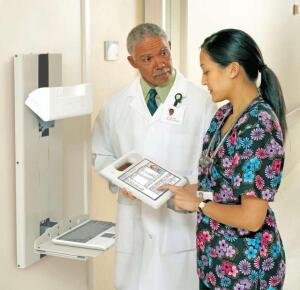DOTmed Industry Sector Report: Time to Change
by
Keith Loria, Reporter | April 16, 2010

An electronic health and medical
records system would be beneficial
This report originally appeared in the March 2010 issue of DOTmed Business News
If you were to travel in any number of places around the globe, you could easily walk up to any ATM, enter your banking information and be able to withdraw funds. So why can't doctors access medical records just as easily? That's the question that drives the government's mandate that all physicians, hospitals and heath professionals must have electronic records/electronic medical records in the next five years.
"Banks only deal with numbers, while with health care there is so much more that goes into it and the more you scratch the surface, the more complicated it becomes," says Jason Launders, senior medical physicist for the ECRI Institute.
With the American Recovery and Reinvestment Act, the government is striving to digitize all patient health records. Currently, only about nine percent of the nation's hospitals utilize some type of EHR, with the majority of those hospitals implementing only the most basic system.
The Federal stimulus package contains $19 billion to accelerate the adoption and meaningful use of electronic health records and health information technology in doctors' offices. This is part of the new administration's plan to use health information technology to help reduce medical costs and improve the quality of care provided to patients.
The ARRA includes incentive payments for hospitals that adopt an EHR, but the timetable for implementation is especially tight. To qualify for the full payment, hospitals will need to demonstrate "meaningful use" no later than October 2012.
"The time for physicians to purchase is now. The idea behind the package is to strongly encourage physicians to buy, then to reward them for doing so," said Stephen Lieber, president and CEO of Health Information and Management Systems Society. "Now is the time for providers and organizations to align themselves with vendors and products that meet the current standards of service and functionality, verify that they are committed to maintaining any future standards as well (and get that in writing), and look at implementing."
Those incentive funds are available through both Medicare and Medicaid, with each having its own set of eligibility criteria. Eligible professionals must choose to accept payments from one, as they are not allowed to collect from both.
For the Medicare incentives, eligible physicians in ambulatory practices that use a qualified EHR are eligible for up to $44,000 or more per physician over a five-year period. These are cash incentives that will be paid directly to care providers or to their employers. Under the Medicaid incentive plan, eligible physicians can receive up to $63,750 to purchase and use qualified EHRs. For practices that have not deployed an EHR, the Medicaid program offers up to $21,250 per physician to help purchase and implement a system (the physician must purchase a system before 2016 to be eligible). Thereafter, the Medicaid incentives offer up to $8,500 per physician for "meaningful use" of the EHR. The "meaningful use" payments will be available for up to five years (with no payments being made after 2021).
